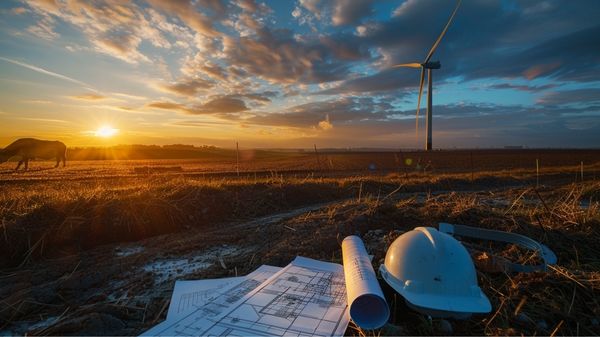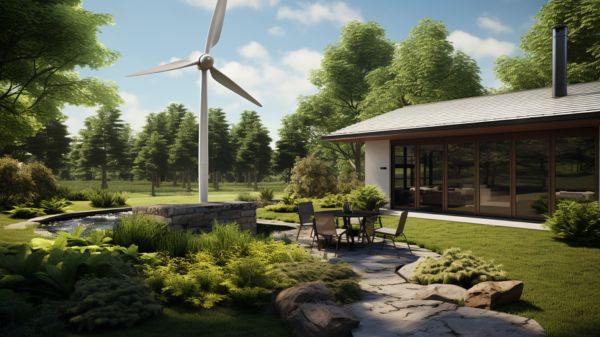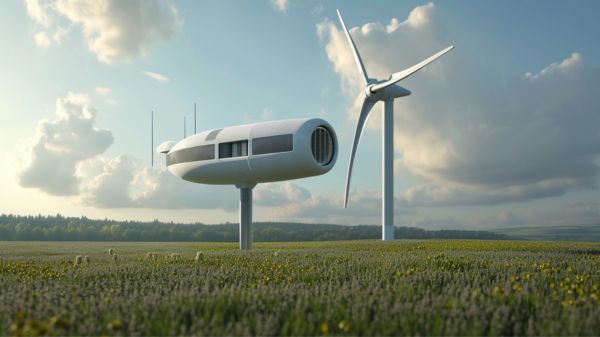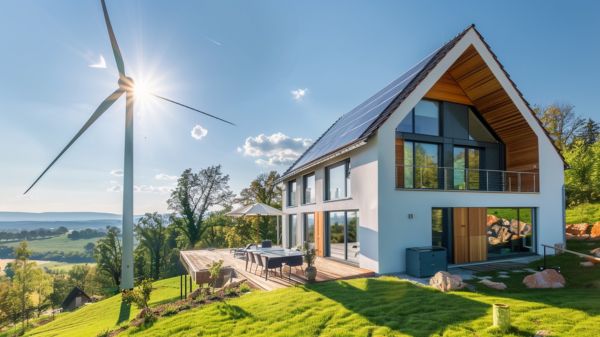When installing a wind turbine, you must secure local permits, such as a conditional use permit, that align with zoning regulations, property setbacks, and height limitations. State compliance with specific energy regulations is mandatory, while federal permits, including FAA clearance for height and NEPA evaluations for environmental impact, are also essential.
Conducting thorough impact assessments, including wildlife studies and noise evaluations, is necessary to address ecological concerns. Additionally, engaging with all stakeholders guarantees community support and regulatory approval. Understanding these multifaceted requirements is vital for successful project execution, and further details will enhance your preparedness for this venture.
Local Permits Overview
When planning to install a wind turbine, you’ll need to navigate the local permitting process, which can vary greatly by municipality. This process generally begins with securing a conditional use permit from the local authority, requiring you to demonstrate that your project aligns with existing land uses, particularly in rural zones.
Local zoning maps, often accessible online, provide essential information regarding permissible locations for wind turbine installation. To guarantee compliance, you’ll likely need to consult with specific agencies, which may include state or federal environmental regulators, especially to assess potential impacts on wildlife.
Additionally, engaging with stakeholders is crucial as federal laws like the Endangered Species Act may influence project outcomes, especially regarding wildlife protection. Advocacy programs can offer training on sustainable practices that support community-driven energy solutions.
Engaging with your community is equally important; active community engagement can’t only foster support for your project but may also mitigate challenges during the permitting process.
Approval typically involves scrutiny from various local boards, including zoning boards and planning commissions, which review applications according to established zoning regulations.
You should expect inspections to verify adherence to permit conditions, so maintaining consistent communication with local agencies can greatly streamline this process.
Understanding these local requirements and actively participating in community discussions will meaningfully enhance your chances of a smooth permitting experience.
State Regulations Explained
Understanding state regulations is essential for anyone looking to install a wind turbine. First and foremost, you must guarantee state compliance, as counties are required to adhere to state legislation regarding the zoning and regulation of wind energy facilities.
It’s important to recognize that while counties can establish their own standards for commercial wind energy facilities, these rules can’t be more stringent than those set by state law.
When considering siting and setback requirements, specific distances must be maintained from community buildings and residences to minimize potential conflicts. Adjustments to these requirements may occur with written consent from property owners, as zoning flexibility can play a significant role in your project.
Townships have the authority to regulate wind turbines through reasonable means tailored to specific township needs and concerns. Furthermore, understanding the economic impact and job creation potential of renewable energy projects can enhance community support for your installation.
To navigate the permitting process effectively, familiarize yourself with the various legal requirements and available resources such as WINDExchange, which provides invaluable information on state and local wind energy ordinances.
Remember, obtaining the necessary permits not only assures compliance but also fosters a smooth changeover to your wind energy project, reinforcing your commitment to sustainable energy solutions for your community. Engaging with local planning commissions and understanding their special use permit processes can further streamline your efforts to install a wind turbine.
Federal Permit Requirements
When considering the installation of a wind turbine, it’s fundamental to understand the federal permit requirements, particularly regarding FAA compliance and NEPA environmental evaluations.
If your turbine exceeds the specified heights or is located near an airport, you’ll need to secure appropriate FAA clearance to guarantee aviation safety, as any potential interference must be rigorously appraised.
Additionally, federal regulations dictate that there are no limits on the placement or height of residential turbines, which can simplify the installation process for homeowners.
Decentralized energy systems have shown to enhance local energy independence, which can be an additional motivation for installing renewable energy technologies like wind turbines.
Furthermore, if your project could impact the environment, adhering to NEPA regulations becomes essential for evaluating and mitigating any adverse effects.
FAA Compliance Necessity
To guarantee your wind turbine installation complies with federal regulations, you must navigate the FAA’s requirements meticulously. Specifically, if your structure exceeds 200 feet in height, you’ll require FAA approval, a critical moment in the FAA Approval Process.
Each turbine in your project must receive individual FAA approval prior to construction, which poses significant FAA Compliance Challenges for developers seeking to streamline their projects. In fact, structures over 200 feet will consistently require this approval to ensure they do not pose a safety risk to airspace users.
Before commencing construction, you’ll need to file a preconstruction notice 90 to 120 days in advance, ensuring you allow enough time for the FAA’s Obstruction Evaluation/Airport Airspace Analysis. This process isn’t merely procedural; it involves a detailed review through safety risk management evaluations, where a panel will assess any potential impacts on airspace safety.
You’ll also need to prepare for interagency coordination, where the FAA notifies other federal agencies, such as the DOD, ensuring that all relevant safety concerns are thoroughly addressed.
Ultimately, engaging with online tools for preliminary screenings can help clarify your project’s standing before diving into the intricacies of FAA compliance, setting a strong foundation for successful project execution.
NEPA Environmental Assessment
Steering through the NEPA Environmental Assessment is essential for any wind turbine project that involves federal actions or lands. Understanding when the NEPA process triggers a review is imperative; for instance, if your project connects to transmission lines managed by BPA or WAPA, or if it requires a Clean Water Act section 404 permit from the U.S. Army Corps of Engineers, you must undergo review.
The assessment entails a thorough examination of environmental impacts and requires exploring alternatives to mitigate potential negative effects. Federal agencies like the Bureau of Land Management or the U.S. Forest Service are typically involved, ensuring compliance with various regulations. Furthermore, projects on state and private land necessitate coordination with local jurisdictions to satisfy their specific requirements.
Public consultation is a critical aspect, as community feedback shapes the documentation of environmental assessments, whether you’re executing an Environmental Assessment (EA) or an Environmental Impact Statement (EIS).
Importantly, the NEPA review timeline can notably affect your project’s development and financing; while smaller actions might be excluded, an EA typically requires several months, and an EIS can extend over a year. By considering these factors early, you place your project on a solid path toward successful compliance with federal permit requirements.
Conducting Impact Assessments
When you conduct impact assessments for wind turbine installations, it’s essential to prioritize wildlife studies and noise impact evaluations, as these elements greatly influence both ecological balance and community acceptance.
You’ll need to assess the potential implications on local wildlife habitats, ensuring that your project doesn’t pose threats to biodiversity, while also evaluating noise levels to mitigate disturbances for nearby residents.
Furthermore, an Environmental Impact Assessment should be conducted to thoroughly identify and address potential impacts on both the environment and the community.
Wildlife Studies Importance
Conducting wildlife studies is essential for understanding the potential impacts of wind energy projects on local ecosystems. These assessments not only facilitate wildlife conservation efforts but also help mitigate the ecological impact of installations.
By engaging in thorough pre-construction evaluations, you guarantee that potential risks to wildlife are identified and addressed early in the planning process. Additionally, incorporating a shadow flicker analysis can help identify how turbine operations may affect local wildlife behaviors, providing further insights for conservation strategies.
Here are some key components of wildlife studies:
- Desktop Analysis: Utilize surveys and satellite imagery for initial wildlife assessments.
- Site Monitoring: Actively observe wildlife behavior at proposed turbine locations.
- Species Distribution Maps: Create maps indicating zones of significant wildlife activity.
- Habitat Assessment: Analyze habitat fragmentation and identify rare ecological attributes.
- Regulatory Consultation: Engage with agencies to pinpoint and avoid high-risk areas.
Noise Impact Evaluation
Evaluating the noise impact of wind turbines is essential for guaranteeing neighborhood satisfaction and regulatory compliance. To effectively assess this impact, you must first familiarize yourself with the established noise limits, which are set at 55 dB LAr,T during the day and 45 dB LAeq at night.
Utilizing measurement techniques such as those outlined in ANSI/AWEA 61400-11, you’ll conduct background noise surveys at affected properties, establishing limits corresponding to prevailing noise levels with a +5 dB margin. It’s important to comprehend how turbine noise is generated and how it varies with wind speed, as this can greatly influence your assessments.
Consequently, employing a combination of SoDAR, nacelle anemometers, and average wind speed measurements across multiple turbines can yield more accurate results while adhering to standardized measurement procedures for turbine noise emissions. Ascertain that your methodology accounts for any critical wind speeds, typically between 6 and 7 m/s, which may affect compliance and complaints.
Planning and Application Process
Before you can install a wind turbine, steering through the planning and application process is essential to guarantee compliance with various regulations. This process involves several key steps that require attention to detail and an understanding of local, state, and federal requirements, as these can markedly affect your project feasibility.
Here are some key aspects you should consider:
- Local Permitting: Understand the specific processes dictated by your region.
- Feasibility Study: Assess the land’s suitability and wind conditions before proceeding.
- Planning Application: Be prepared for the application timeline, as this may take several months or even years.
- Environmental Considerations: Complete necessary assessments to address site impacts.
- Conditional Use Permits: Determine if additional permits are needed based on local regulations.
Securing land rights and traversing the maze of local zoning ordinances are also vital. Moreover, successful compliance with these regulations directly impacts your ability to contribute to the renewable energy sector, which has seen wind power emerge as a leading alternative to fossil fuels.
As you commence on this journey, staying informed and organized will help streamline your efforts, ultimately leading towards successful compliance and a smoother path to installation.
Additional Considerations
When you’re considering the installation of a wind turbine, several additional factors can greatly impact the success of your project.
First, understanding turbulence impacts is essential; high turbulence from nearby obstructions can result in increased vibrations and stresses on the turbine, ultimately affecting its lifespan and efficiency.
As a result, you should conduct a thorough terrain analysis to identify suitable locations, especially avoiding areas with significant wind shadows created by hills or dense forests, which can severely hinder performance.
Moreover, turbine operation greatly depends on site-specific wind resource measurements, emphasizing the need for detailed data collection prior to installation. It is also crucial to consider wind speed assessments to ensure that the selected site has adequate wind resources for effective energy production.
Additionally, assess existing and potential future obstacles, such as trees or structures that could grow in height, ensuring they won’t interfere with turbine efficiency.
Accessibility is another vital aspect; access roads must support the transportation of large components and allow for maintenance equipment, particularly in rocky or mountainous regions where costs may rise due to challenging terrain.
Lastly, proximity to power transmission infrastructure can play a significant role in minimizing energy transfer costs, especially considering that energy companies might contribute to those expenses.
Thoroughly evaluating these factors will help you make informed decisions and foster successful turbine installation, bringing you one step closer to being part of the wind energy community.
Importance of Building Permits
Understanding the importance of building permits is vital for anyone looking to install a wind turbine. These permits not only guarantee compliance with building codes but also prioritize construction safety, thereby safeguarding both the environment and community.
Failure to acquire the necessary permits can lead to considerable project delays or even full stoppage, which ultimately affects your timeline and investment. Here are several important aspects of building permits you should consider:
- Federal Regulations: Projects impacting federal lands may require specific federal permits.
- Local Compliance: Local zoning ordinances may necessitate additional permits, often involving public input and hearings.
- Environmental Assessments: Detailed documentation is essential for understanding the environmental impact of your project.
- Strategic Planning: Engaging with local stakeholders early can mitigate potential opposition.
- Permit Variability: The timing and requirements for permits can vary greatly based on state and local regulations.
- Ensuring that your project aligns with regulatory standards for energy consumption can further facilitate timely permit acquisitions and improve sustainability outcomes.
Being well-informed about building permit requirements not only paves the way for seamless project execution but also demonstrates your commitment to adhering to community standards and regulations. This fosters a stronger relationship with local residents and authorities.
Navigating Zoning Ordinances
How can you guarantee your wind turbine project aligns with local zoning regulations? To navigate zoning challenges effectively, begin by contacting your local planning department, as they can provide clarity on the specific ordinances governing wind energy installations in your area.
Understand that zoning regulations dictate where turbines can be installed, maximum height limits, and necessary setbacks from property lines and natural features. Engage the community early; proactive dialogue can greatly alleviate potential objections and foster support for your project.
Identify the zoning districts where turbines are permitted, typically in agricultural or industrial classifications. It’s also necessary to prepare detailed plans addressing the turbine model and installation site, as these will form the basis of your permit application.
Be aware that local ordinances may require public hearings, highlighting the importance of transparency in your project’s intent. By proactively outlining your compliance strategy and involving community members, you not only guarantee adherence to local regulations but also build trust and rapport among those affected by your wind energy initiative.
Ultimately, a combined focus on adherence to zoning laws and community engagement paves the way for a successful wind turbine installation.
Future of Wind Energy Regulations
The regulatory landscape for wind energy is evolving rapidly, shaped by a mix of increasing permitting restrictions and innovative approaches in different regions. As you maneuver through the complexities of these changes, it’s crucial to stay informed about the key wind energy trends influencing future regulations.
- Permitting Challenges: Expect increased ordinances, with a sixteen-fold rise in restrictions from 2003 to 2023.
- Setback Requirements: Be aware that average setback requirements have surged by 304%, potentially limiting project viability.
- Capacity Concerns: Should all counties impose stringent zoning laws, the U.S. may see a drastic reduction in wind power capacity, jeopardizing net-zero targets.
- Varied Processes: Understand that local and state-level permitting processes can differ greatly, which may impact project timing and feasibility.
- European Innovations: Europe is leading in streamlining its permitting processes, providing a valuable blueprint for U.S. initiatives.
As regulatory changes continue to shape this sector, achieving ideal wind energy deployment requires maneuvering through these intricate permitting landscapes while advocating for reforms that support sustainable growth.
Staying connected with local advocacy groups can also enhance your efforts in promoting favorable wind policy environments.
Frequently Asked Questions
How Long Does the Permitting Process Typically Take?
The permitting process typically entails significant timeline expectations influenced by various factors, including project size and local opposition. Generally, it can take anywhere from a few months to over a year, with permitting delays arising from environmental reviews or interagency coordination issues.
Each jurisdiction has its own regulations that can further complicate the timeline, necessitating thorough preparation and understanding of local requirements to mitigate potential holdups effectively.
What Are the Costs of Obtaining Wind Turbine Permits?
To obtain wind turbine permits, you’ll encounter a range of permit fees, typically falling between $45 and $10,000, with an average cost breakdown around $2,666. It’s important to take into account additional unexpected expenses, which may include labor fees and environmental evaluation costs, alongside standard fees.
Local jurisdictions often impose variations, so it’s vital to research specific regulations applicable in your area to effectively manage the overall permitting cost for your project.
Can I Appeal if My Permit Application Is Denied?
When your permit application faces denial, think of it as a locked door you can potentially open. You can indeed initiate the appeal process. This involves promptly submitting an appeal that adheres to your state or local regulations within specified timelines.
Throughout this process, make sure you provide any necessary documentation or evidence to strengthen your case, as this can greatly influence the decision in your favor during the administrative review.
Are There Specific Insurance Requirements for Wind Turbine Installations?
Yes, there are specific insurance requirements for wind turbine installations, which often necessitate an extensive risk assessment. You’ll need various insurance policies, including builders’ risk and general liability to cover potential damages and third-party claims.
Additionally, equipment breakdown and commercial auto insurance can also be essential. Make sure you evaluate coverage limits thoroughly, as exclusions may impact claims related to operation or natural disasters, potentially leading to significant financial liabilities if not adequately addressed.
How Do I Find Local Resources for Permitting Assistance?
To find local resources for permitting assistance, start by reaching out to local agencies, such as zoning offices, which can provide specific maps and regulations relevant to your project.
Additionally, utilize online resources, including state energy commission websites, to identify necessary permits and associated processes. Moreover, reviewing local wind energy ordinances will enhance your understanding of specific requirements, ensuring compliance and facilitating the overall permitting process effectively.
Conclusion
In today’s ever-evolving landscape of renewable energy, maneuvering through the maze of regulations and permits for installing a wind turbine can feel like a contest of bureaucratic endurance, where one must master the art of patience while meticulously ensuring compliance with local, state, and federal requirements. It’s as if obtaining permission from a legion of regulatory deities is a rite of passage, prompting you to question whether a simple breeze is truly worth the regulatory storm it incites.




